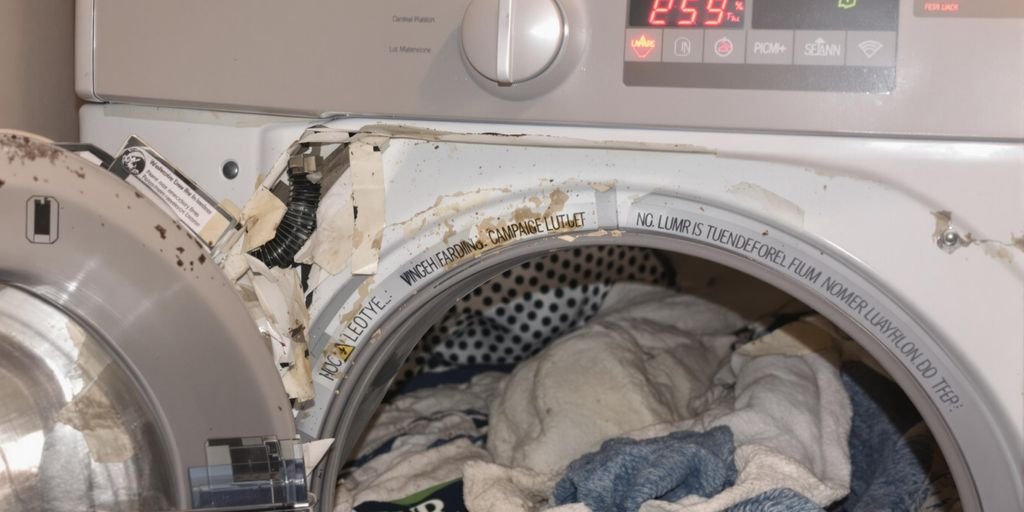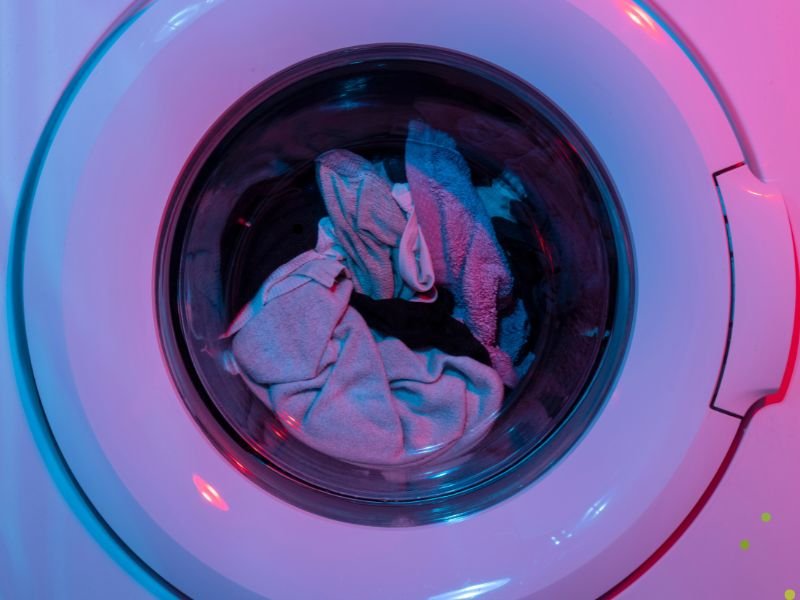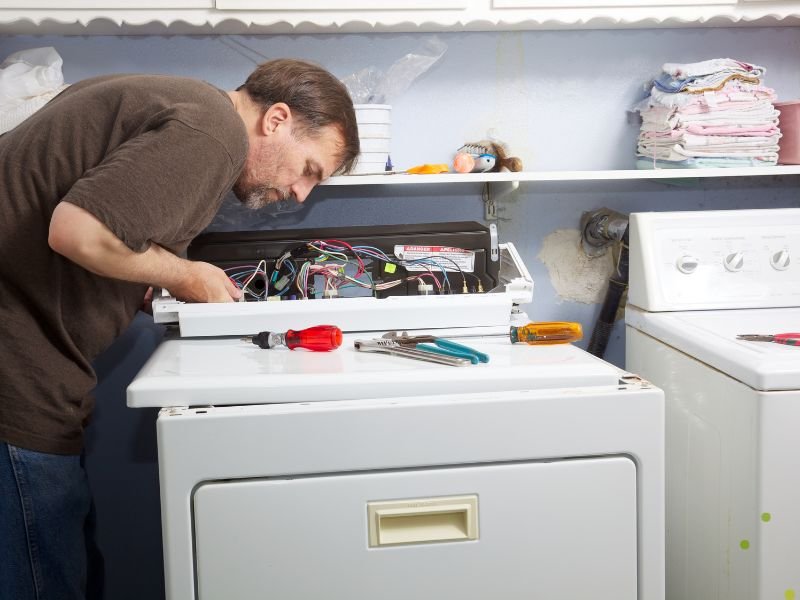
Your dryer is one of those appliances you don’t think about much—until it stops working right. And let’s face it, nobody likes dealing with damp clothes or weird noises when all you want is clean laundry. If your dryer’s acting up, it might be time to pay attention before a small issue turns into a big problem.
Key Takeaways
- Weird noises like rattling, squealing, or buzzing could mean parts are wearing out.
- If clothes are still damp or drying takes longer, something’s likely wrong.
- Burning smells or overheating are clear signs to stop using your dryer immediately.
- A drum that won’t spin or controls that don’t respond might need professional help.
- Excess lint or visible damage to parts like the belt or seal shouldn’t be ignored.
Unusual Noises Coming From Your Dryer
Rattling or Thumping Sounds
Hearing a rattling or thumping noise every time your dryer runs? This could be a sign of loose objects, like coins or buttons, stuck in the drum or blower wheel. Ignoring these sounds might lead to bigger mechanical issues down the road. Check the drum and clean out any foreign items to prevent damage. Need help? Call us today and let our experts assist with your dryer!
Squealing or Grinding Noises
A high-pitched squeal or grinding noise isn’t just annoying—it’s a red flag. Often, this points to worn-out bearings, a faulty drum roller, or a damaged drive belt. If left unchecked, these problems can worsen, leading to costly repairs or even a complete breakdown.
Buzzing or Humming That Won’t Stop
When your dryer emits a constant buzzing or humming, it’s usually struggling to start or keep running. This might indicate an issue with the motor or capacitor. Electrical components like these can fail over time, so it’s best to address the problem before your dryer completely gives out. For more details on these types of issues, check out our guide to common dryer issues.
Clothes Taking Longer to Dry Than Usual
Damp Clothes After a Full Cycle
If your clothes are still damp after running a full drying cycle, it’s a sign something’s off. Dryers are designed to finish the job in one go, so when they don’t, you might be dealing with a clogged vent, a failing heating element, or even an overloaded drum. First, check if you’re stuffing it too full—sometimes, it’s just that simple. If not, it’s worth inspecting the lint trap and exhaust duct for blockages.
Increased Energy Bills Without Explanation
Nobody likes surprise spikes in their energy bills. If you’ve noticed an unexplained increase, your dryer could be the culprit. A dryer that takes longer to dry uses more electricity, plain and simple. Malfunctioning parts, like a thermostat or heating coil, can also make the machine work harder than it should. Keep an eye on your energy usage, and if there’s a sudden jump, it might be time to give your dryer some attention.
Lint Trap Filling Up Faster Than Normal
A lint trap that seems to fill up after every load could mean trouble. Excess lint might be a sign that the dryer’s vent is blocked, causing lint to back up into the trap. This not only makes the dryer less efficient but also creates a fire hazard. Regularly cleaning the trap and checking the vent for blockages can help, but if it keeps happening, you might need a professional to take a closer look.
When your dryer starts acting up, don’t ignore the signs. Small issues can quickly turn into bigger problems if left unchecked. Stay ahead of potential dryer issues!
Overheating or Burning Smells During Operation
Dryer Feels Hot to the Touch
If your dryer feels unusually hot after running, it’s a sign something might be wrong. Overheating can happen when airflow is restricted, often due to lint build-up in the vent or exhaust. This not only stresses the machine but can also lead to serious safety risks if ignored. Regularly check the vent and clean it to avoid this issue.
Burning Odor Coming From the Drum
A burning smell while your dryer is running is never normal. It could mean lint has become trapped in the heating element or vent, creating a fire hazard. A burning smell from a dryer is a red flag that should never be overlooked. Stop using the dryer immediately and inspect for lint accumulation or damaged components that might be causing the odor.
Clothes Smelling Scorched After Drying
When your freshly dried clothes come out smelling burnt, it’s a clear indicator of overheating. This can happen if the thermostat or heating element malfunctions, causing the dryer to run too hot. Check for scorched lint in the trap or drum, and consider calling a technician if the issue persists.
Overheating in dryers is not just a minor inconvenience—it’s a potential fire hazard. Always address these signs immediately to protect your home and family.
Drum Not Spinning or Turning Properly
Dryer Drum Stuck Mid-Cycle
Ever had your dryer stop spinning halfway through a cycle? It’s frustrating, right? This is often caused by a snapped or worn-out drum belt. The belt is what keeps the drum turning, and when it breaks, the dryer can’t do its job. Another possible culprit is a faulty drum motor or seized drum rollers. If you hear the motor running but the drum stays still, that’s a clear sign something’s off. Ignoring this issue could lead to bigger problems down the road.
Clothes Bunching Up Unevenly
When your clothes come out in a tangled mess, it might mean the drum isn’t spinning smoothly. Uneven spinning can happen if the drum rollers or bearings are worn out. This not only messes up your laundry but also puts extra strain on the motor, which could eventually fail. To avoid this, check for any unusual jerking or wobbling during operation. If you notice any issues, don’t hesitate to call us for fast and reliable service!
Unresponsive Start Button or Controls
If pressing the start button does nothing, it could be an electrical issue or even a problem with the dryer’s control board. But sometimes, it’s as simple as a broken door switch. The dryer won’t start if it thinks the door is open. Double-check the door latch and ensure it’s closing properly. If the controls seem completely dead, it’s time to call in a professional.
A dryer that won’t spin isn’t just inconvenient—it can also be a safety hazard. Addressing the issue early can save you money and keep your home safe.
| Common Causes for a Dryer Not Spinning | Possible Fixes |
| Broken drum belt | Replace the belt |
| Worn drum rollers or bearings | Inspect and replace parts |
| Faulty motor | Repair or replace the motor |
| Electrical or control board issues | Professional diagnosis |
For more details, check out common causes for a dryer not spinning, including solutions like fixing a broken drum belt or addressing a worn drum bearing.
Visible Wear and Tear on Dryer Components
Cracked or Warped Dryer Belt
Over time, the dryer’s belt can start to show signs of wear, like cracks or even warping. This small but vital component keeps the drum spinning smoothly. If it breaks, the dryer won’t function properly, and your laundry routine will grind to a halt. You might notice a squeaking noise or uneven tumbling as early warning signs. Replacing the belt promptly can save you from bigger headaches down the line.
Damaged or Loose Door Seal
A damaged or loose door seal might seem minor, but it can lead to some frustrating issues. When the seal isn’t tight, heat escapes, making the dryer work harder than it should. This not only wastes energy but also means your clothes may take longer to dry. Check for any gaps, tears, or signs of wear around the door. If you spot any, it’s time to replace the seal.
Rust or Corrosion Inside the Drum
Rust or corrosion inside the drum is a red flag you don’t want to ignore. It not only damages the machine but can also stain your clothes. Moisture left behind after cycles or poor ventilation can cause this issue. Keeping the drum dry and clean after each use can help prevent rust from forming. If you see any rusty spots, address them immediately to avoid further damage.
Regularly inspecting your dryer for visible wear and tear can save you money and hassle in the long run. Don’t wait for small issues to become costly repairs.
- Inspect the dryer belt for cracks or stretching.
- Check the door seal for gaps or damage.
- Wipe down the drum after each use to prevent moisture buildup.
For more information on avoiding risks like fire hazards and expensive repairs, make sure to maintain your dryer vents.
Frequent Error Codes or Malfunctioning Settings
Error Messages Displayed on the Panel
When your dryer flashes error codes on its display, it’s trying to tell you something is wrong. These messages often point to specific issues, like a clogged vent or a faulty sensor. Ignoring these warnings can lead to bigger problems down the line. For example, if you notice recurring error codes, it might be time to consult your manual or reach out to a professional. Sometimes, a quick fix like power cycling the appliance (turning it off, unplugging it, and plugging it back in) can resolve the issue.
Inconsistent Temperature Settings
Have you noticed your dryer running too hot or not heating at all? This could mean the temperature sensor or thermostat is acting up. Inconsistent heat levels not only make drying clothes a hassle but can also damage delicate fabrics. Check if the settings you’ve chosen match the actual performance. If not, it’s worth having a technician look into it.
Dryer Shutting Off Mid-Cycle
Few things are more frustrating than a dryer that quits halfway through a cycle. This could be due to an overheating issue, a failing motor, or even a glitch in the control panel. Start by cleaning the lint trap and ensuring proper airflow. If the problem persists, professional service might be necessary to avoid further wear and tear.
Frequent malfunctions in your dryer’s settings aren’t just a nuisance—they’re a sign that something deeper might be wrong. Addressing these issues early can save you from costly repairs or even replacing the dryer altogether.
Excessive Lint Build-Up in and Around the Dryer
Lint Accumulating Behind the Dryer
When lint starts to pile up behind your dryer, it’s more than just an eyesore—it’s a potential fire hazard. Excessive lint build-up can block airflow, making your dryer work harder and less efficiently. Over time, this can lead to overheating and even damage to internal components. Regularly check behind your dryer and clean any visible lint to prevent these issues.
Clogged Vent or Exhaust Duct
A clogged vent or exhaust duct is a serious problem that can cause your dryer to overheat and fail. If you notice that your clothes are still damp after a full cycle or the dryer feels unusually hot, it could be due to a blockage. Use a vent cleaning kit or hire a professional to clear out the duct. Ignoring this issue can lead to costly repairs or even safety risks.
Reduced Airflow During Operation
Have you felt weak airflow coming from your dryer’s vent? This is a telltale sign of lint build-up restricting air circulation. Reduced airflow not only extends drying times but also increases energy consumption. To check for this, place your hand near the vent while the dryer is running. If the airflow feels faint, it’s time for a thorough cleaning.
Lint build-up is one of the key indicators that your dryer vent requires cleaning. Don’t wait until it’s too late—address these signs early to keep your dryer running smoothly and safely. Don’t let lint build-up affect your dryer’s performance. Contact us today for a professional vent cleaning service!
Wrapping It Up
So, there you have it. If your dryer is making weird noises, taking forever to dry clothes, or just acting off, don’t ignore it. These small signs can turn into big problems if you wait too long. A quick check or a call to a repair service now can save you a lot of hassle later. Plus, who wants to deal with a pile of wet laundry when the dryer finally gives out? Stay ahead of the game, and keep your dryer running smoothly.
Frequently Asked Questions
Why is my dryer making strange noises?
Odd sounds like rattling, squealing, or buzzing could mean parts inside your dryer are loose or worn out. It’s a sign you should get it checked.
What should I do if my clothes are still damp after drying?
If your clothes aren’t drying fully, your dryer might have a clogged vent, a failing heating element, or a full lint trap. Try cleaning the lint trap first.
Is it normal for my dryer to feel very hot during use?
No, a dryer that gets too hot could be a safety risk. It might have a blocked vent or a faulty thermostat. Stop using it and call a technician.
Why won’t my dryer drum spin?
If the drum isn’t turning, it could be due to a broken belt, a stuck motor, or an electrical issue. You may need professional help to fix it.
What causes a burning smell when using my dryer?
A burning smell might mean lint is stuck in the vent or drum, or there’s an overheating problem. Turn off the dryer and inspect it immediately.
How can I prevent lint buildup in my dryer?
Clean the lint trap after every load, and check the vent and exhaust duct regularly to keep them clear. This helps your dryer work safely and efficiently.



